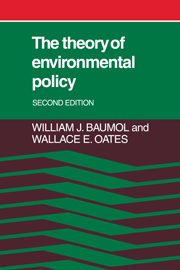We have now completed our discussion of the basic theoretical framework. There is much to the theory of externalities that we have made no attempt to cover, for our central objective is the formulation of an analytic structure for the study of environmental policy.
At this point, we seem to have an illuminating, but somewhat destructive, set of results – one that creates severe difficulties for the application of theory to practical problem solving. In this part of the book, we decrease the level of abstraction of our discussion and seek to approach more closely the problems of application. Here too, we will encounter obstacles, though of a different kind from the theoretical complications of Part I. For example, we will find reason to suspect that many proposed environmental programs may well make the distribution of income more unequal.
Nevertheless, we will argue that these obstacles do not preclude the design of effective environmental programs, and, in spite of the difficulties encountered in Part I, that economic theory can be very helpful in the design of these programs.
In particular, Chapter 11 presents a proposal for a feasible tax or fee program. We suggest what we believe to be a practical and effective procedure for the protection of the environment: the use of pollution charges to achieve a predetermined set of standards for environmental quality. Some degree of arbitrariness in the design of such standards is inevitable.
